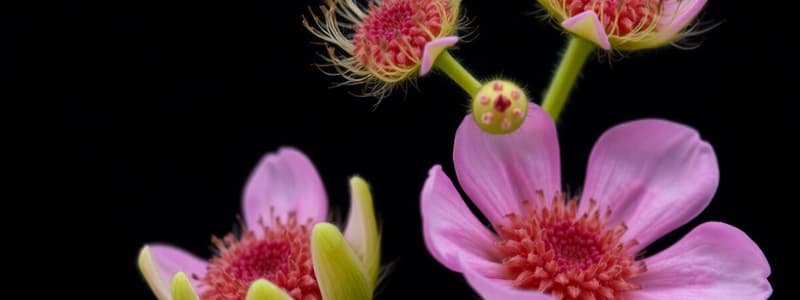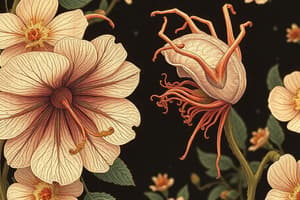Podcast
Questions and Answers
Which of the following is a disadvantage specifically associated with sexual reproduction, unlike asexual reproduction?
Which of the following is a disadvantage specifically associated with sexual reproduction, unlike asexual reproduction?
- The potential for a rapid increase in population size under favorable conditions.
- The lack of genetic variation among offspring.
- The vulnerability of all individuals to the same diseases.
- The necessity of finding a mate, which requires time and energy. (correct)
In the context of plant reproduction, which structure is responsible for producing pollen grains?
In the context of plant reproduction, which structure is responsible for producing pollen grains?
- Ovule
- Stigma
- Ovary
- Anther (correct)
During animal development, what is the primary purpose of the acrosome found in sperm cells?
During animal development, what is the primary purpose of the acrosome found in sperm cells?
- To release digestive enzymes that break down the outer layers of the egg. (correct)
- To protect the sperm's DNA from damage as it travels to the egg.
- To recognize and bind to receptors on the egg plasma membrane.
- To provide energy for the sperm's movement through the flagellar tail.
Which stage of animal development involves rapid mitotic cell divisions without an increase in the overall size of the embryo?
Which stage of animal development involves rapid mitotic cell divisions without an increase in the overall size of the embryo?
If a species relies solely on asexual reproduction, what is a potential long-term consequence for its adaptability to changing environments?
If a species relies solely on asexual reproduction, what is a potential long-term consequence for its adaptability to changing environments?
During gastrulation, the formation of three germ layers is a critical event. What is the significance of these layers?
During gastrulation, the formation of three germ layers is a critical event. What is the significance of these layers?
What primary advantage does sporulation offer certain organisms under unfavorable environmental conditions?
What primary advantage does sporulation offer certain organisms under unfavorable environmental conditions?
How does the bindin protein in sperm contribute to the process of fertilization?
How does the bindin protein in sperm contribute to the process of fertilization?
Consider a plant species that reproduces through fragmentation. What characteristic would you expect to observe in this species?
Consider a plant species that reproduces through fragmentation. What characteristic would you expect to observe in this species?
Which of the following accurately describes the sequence of events during animal development, starting from gamete formation?
Which of the following accurately describes the sequence of events during animal development, starting from gamete formation?
How does the presence of yolk in an egg cell influence embryonic development?
How does the presence of yolk in an egg cell influence embryonic development?
In a flower, what is the primary function of the petals?
In a flower, what is the primary function of the petals?
An organism that reproduces via fission creates two new organisms. What is a key characteristic in these new organisms?
An organism that reproduces via fission creates two new organisms. What is a key characteristic in these new organisms?
What role does the style play in plant reproduction?
What role does the style play in plant reproduction?
A population of bacteria is exposed to a new antibiotic. Which reproductive strategy would likely allow the population to adapt more quickly?
A population of bacteria is exposed to a new antibiotic. Which reproductive strategy would likely allow the population to adapt more quickly?
During fertilization, which of the following events occurs first?
During fertilization, which of the following events occurs first?
What is the function of the ovary in plant reproduction?
What is the function of the ovary in plant reproduction?
In organisms that reproduce asexually via budding, what is the genetic relationship between the parent and the offspring?
In organisms that reproduce asexually via budding, what is the genetic relationship between the parent and the offspring?
How does the relatively large size of the egg cell compared to the sperm cell contribute to successful fertilization and development?
How does the relatively large size of the egg cell compared to the sperm cell contribute to successful fertilization and development?
If a plant breeder wants to create a new variety of flower with unique characteristics, which method of reproduction would be most effective?
If a plant breeder wants to create a new variety of flower with unique characteristics, which method of reproduction would be most effective?
Flashcards
Development (in biology)
Development (in biology)
Series of changes, taking on successive forms during its life cycle.
Reproduction
Reproduction
Process by which animals produce offspring to continue their species.
Sexual Reproduction
Sexual Reproduction
Reproduction involving the combination of genetic material from two different cells, resulting in diverse offspring.
Asexual Reproduction
Asexual Reproduction
Signup and view all the flashcards
Budding
Budding
Signup and view all the flashcards
Fission
Fission
Signup and view all the flashcards
Fragmentation
Fragmentation
Signup and view all the flashcards
Sporulation
Sporulation
Signup and view all the flashcards
Flower
Flower
Signup and view all the flashcards
Sepals
Sepals
Signup and view all the flashcards
Petals
Petals
Signup and view all the flashcards
Stamen
Stamen
Signup and view all the flashcards
Anther
Anther
Signup and view all the flashcards
Filament (of stamen)
Filament (of stamen)
Signup and view all the flashcards
Pistil/Carpel
Pistil/Carpel
Signup and view all the flashcards
Stigma
Stigma
Signup and view all the flashcards
Style
Style
Signup and view all the flashcards
Ovary (in plants)
Ovary (in plants)
Signup and view all the flashcards
Ovule
Ovule
Signup and view all the flashcards
Gametogenesis
Gametogenesis
Signup and view all the flashcards
Study Notes
Development and Reproduction
- Development is a series of changes an organism undergoes throughout its life cycle.
- Reproduction is how animals produce offspring to continue their species.
Sexual Reproduction
- Involves the combination of genetic material from two different cells to produce offspring.
Advantages
- Results in diverse offspring due to genetic variation.
- Allows for selective breeding.
- Enables species to adapt to new environments.
Disadvantages
- Requires time and energy to find a mate.
- Impossible for isolated individuals.
- Searching for mates can expose individuals to dangers.
- Pregnancy can be lengthy.
Asexual Reproduction
- Involves only one parent, producing genetically identical offspring.
Types
- Budding is when a new organism grows on the parent's body via mitosis (e.g., hydra, yeast, cactus).
- Fission is cell division in prokaryotes, creating two identical cells (e.g., bacteria, E. coli).
- Fragmentation is when a parent organism breaks into fragments that grow into new organisms.
- Sporulation is the formation of spores from vegetative cells during unfavorable conditions.
Advantages
- Allows rapid population growth in favorable conditions.
- Requires only one parent.
- Is faster and more energy-efficient than sexual reproduction.
Disadvantages
- Does not lead to genetic variation.
- Species may only be suited to one habitat.
- Diseases can affect entire populations.
Plant Reproduction: The Flower
- Flowers are the reproductive structures in flowering plants, consisting of four major whorls.
Sepals
- The outermost whorl, collectively called the calyx.
Petals
- Located inside the sepals, collectively called the corolla, and are often brightly colored.
Stamen
- The male reproductive structure, consisting of the anther and filament.
- Anther contains microsporangia that develop into pollen grains.
- Filament supports the anther.
Pistil/Carpels
- The innermost whorl, the female reproductive structure, consisting of the stigma, style, and ovary.
- Stigma receives pollen during pollination.
- Style connects the stigma to the ovary.
- Ovary contains ovules and eventually becomes the fruit.
- Ovule contains megasporangia and eventually becomes the seed.
Stages of Animal Development
Gametogenesis
- Is stage of development that yields haploid gametes
Fertilization
- A single sperm cell combines with a single egg cell to form a zygote.
- A human egg cell is about 16 times larger than a human sperm cell.
- Eggs contain yolk to support embryo growth.
- Sperm contains tightly packed DNA, a flagellar tail, and mitochondria for movement.
- The plasma membrane of sperm contains bindin proteins for recognizing and binding to egg receptors.
- The acrosome in the sperm head contains digestive enzymes to degrade the egg's outer layers.
Cleavage
- Rapid mitotic cell divisions without increasing the embryo's overall size.
- Results in a blastula.
Gastrulation
- Rearrangement of cells in the blastula to form embryonic tissue layers.
- Forms three germ layers: ectoderm, mesoderm, and endoderm, which give rise to specific tissues and organs.
- Cleavage cell divisions can occur as frequently as every 10 minutes, versus the typical 18-24 hours.
Studying That Suits You
Use AI to generate personalized quizzes and flashcards to suit your learning preferences.




